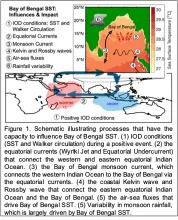The aim of NEW NORMAL (NEar surface Warming in the Indian Ocean and Rainfall Monsoon Anomaly Links) is to establish new international collaborations between scientists in the UK and India, and in particular world leading experts in Indian Ocean warming and monsoon dynamics, in order to achieve the following:
- Determine how Indian Ocean warming (sources and pathways) is altering the ocean precursors for the South Asian monsoon, i.e., Bay of Bengal sea surface temperature, that lead to extreme monsoon rainfall events.
- Quantify the predictability of ocean processes that lead to extreme rainfall events by identifying and characterising long term trend warming trends in the Indian Ocean and their impact on Bay of Bengal sea surface temperature.
- Organise a workshop/consortium to promote knowledge exchange with international and UK partners, combining added value between existing programmes (e.g. SOLSTICE, ACCORD, WCSSP-India) and NEW NORMAL, and lay the groundwork for bringing the wider international scientific community together to pursue a large scale programme on climate extremes in the Indian Ocean.
NEW NORMAL



